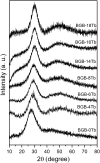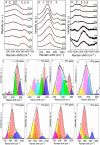Magneto-optical borogermanate glasses and fibers containing Tb3
- PMID: 33972670
- PMCID: PMC8110553
- DOI: 10.1038/s41598-021-89375-1
Magneto-optical borogermanate glasses and fibers containing Tb3
Abstract
New glass compositions containing high concentrations of Tb3+ ions were developed aiming at the production of magneto-optical (MO) fibers. This work reports on the structural and MO properties of a new glass composition based on (100 - x)(41GeO2-25B2O3-4Al2O3-10Na2O-20BaO) - xTb4O7. Morphological analysis (HR-TEM) of the sample with the highest concentration of Tb3+ ions confirmed the homogeneous distribution of Tb3+ ions and the absence of nanoclusters. All the samples presented excellent thermal stability against crystallization (ΔT > 100 °C). An optical fiber was manufactured by a fiber drawing process. The UV-Vis spectra of the glasses showed Tb3+ electronic transitions and optical windows varying from 0.4 to 1.6 μm. The magneto-optical properties and the paramagnetic behaviors of the glasses were investigated using Faraday rotation experiments. The Verdet constant (VB) values were calculated at 500, 650, 880, 1050, 1330, and 1550 nm. The maximum VB values obtained at 650 and 1550 nm for the glass with x = 18 mol% were -128 and - 17.6 rad T-1 m-1, respectively. The VB values at 500 and 1550 nm for the optical fiber containing 8 mol% of Tb4O7 were - 110.2 and - 9.5 rad T-1 m-1, respectively, while the optical loss at around 880 nm was 6.4 dB m-1.
Conflict of interest statement
The authors declare no competing interests.
Figures











References
-
- Qiu X, Wu B, Liu Y, Wen F. Study on mode coupling characteristics of multimode magneto-optical fibers. Opt. Commun. 2020;456:124707. doi: 10.1016/j.optcom.2019.124707. - DOI
-
- Valeanu M, et al. The relationship between magnetism and magneto-optical effects in rare earth doped aluminophosphate glasses. J. Phys. D Appl. Phys. 2016;49(7):075001. doi: 10.1088/0022-3727/49/7/075001. - DOI
-
- Kruk A, et al. Transparent yttrium oxide ceramics as potential optical isolator materials. Opt. Appl. 2015;45(4):585–594. doi: 10.5277/oa150413. - DOI
-
- Chen Q, Wang H, Chen Q. Structural and properties of heavy metal oxide Faraday glass for optical current transducer. J. Non-Cryst. Solids. 2015;429:13–19. doi: 10.1016/j.jnoncrysol.2015.08.031. - DOI
Grants and funding
LinkOut - more resources
Full Text Sources
Other Literature Sources
Miscellaneous

